Everyone comes to Kyoto to walk through the orange gates, but few realize the Fushimi Inari Hike is an actual climb, not just a photo stop. Here’s how to do it right.

When people picture Kyoto, they picture the red torii gates of Fushimi Inari. What most don’t realize is that those gates line an entire mountain trail, and walking it is an experience of its own which goes way beyond the pretty picture.
The Fushimi Inari Hike climbs up Mount Inari behind the shrine, winding through forests, smaller shrines, and neighborhoods before looping back down.
In this guide, I’ll explain what the full Fushimi Inari Shrine hike actually involves, how long it takes, what to expect along the way, and the quieter hidden trails where you can still find the feeling everyone comes looking for.
Overview: What the Fushimi Inari Hike Really Is
The Fushimi Inari Hike starts behind Kyoto’s most photographed shrine, where thousands of orange torii gates stretch up the slope of Mount Inari. The shrine itself sits at the base, dedicated to Inari Ōkami, the Shinto deity of rice and prosperity, and the trail beyond it is part of the same sacred complex.
Most people think of it as a temple walk, but it’s technically a full mountain loop, about 4 kilometers or 2,5 miles long with an elevation gain of roughly 230 meters (750 ft).
The path begins in the crowded lower section filled with souvenir stands and food stalls, then splits into a network of smaller stone stairways that lead deeper into the forest. Along the way, there are dozens of sub-shrines, each with offerings, lanterns, and statues of foxes, messengers of Inari. Signs in both Japanese and English mark the route, though getting lost isn’t really possible; the torii guide you the entire way.
What makes the Fushimi Inari Shrine hike unusual is how it shifts from a tourist landmark to a place of quiet devotion within minutes. The lower gates echo with chatter and camera clicks, but higher up, you mostly hear wind and bells. By the time you reach the halfway viewpoint, Kyoto spreads faintly below, and it feels like you’ve entered another ecosphere.

Duration: How Long Does the Fushimi Inari Hike Take?
The Fushimi Inari Hike can take anywhere from half an hour to three hours depending on how far you go. The main loop to the summit of Mount Inari is about four kilometers long. Walking at a relaxed pace, with short stops at shrines or vending machines, it usually takes around two and a half hours round trip.
Most visitors, though, stop halfway at Yotsutsuji Intersection. That point sits roughly 45 minutes from the base and has the best open view over Kyoto. From there, the path splits into two routes that circle up to the top and rejoin on the way down. The higher you go, the quieter it gets, and the fewer people you’ll meet.
If you visit early in the morning, before 8 a.m., you can complete the full Fushimi Inari Shrine hike before the crowds build up. Starting later in the afternoon also works, though the forest gets dim fast once the sun drops behind the hill. Either way, it’s an easy-to-moderate climb, steep in sections but never technical, and paved all the way to the summit.
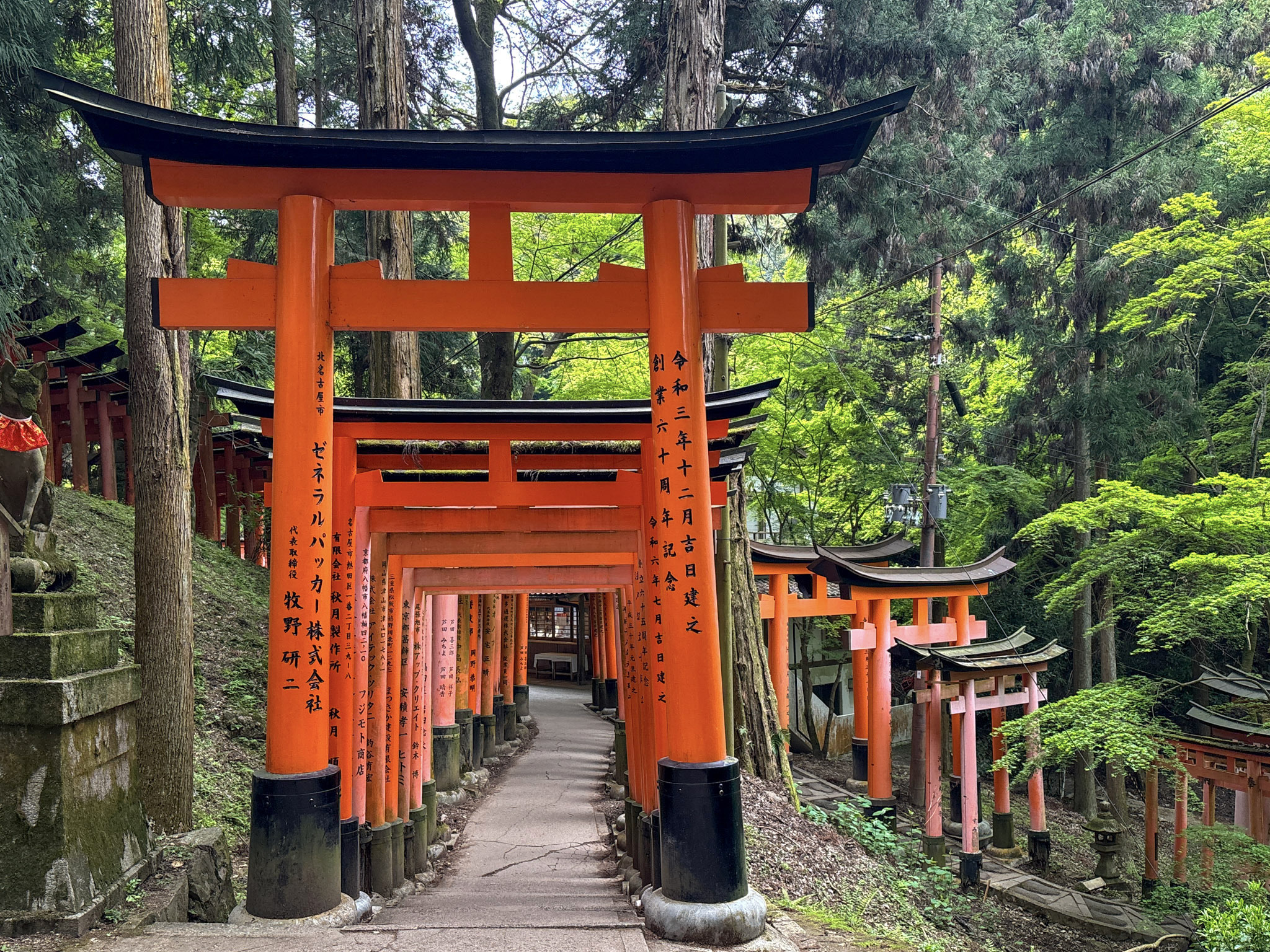

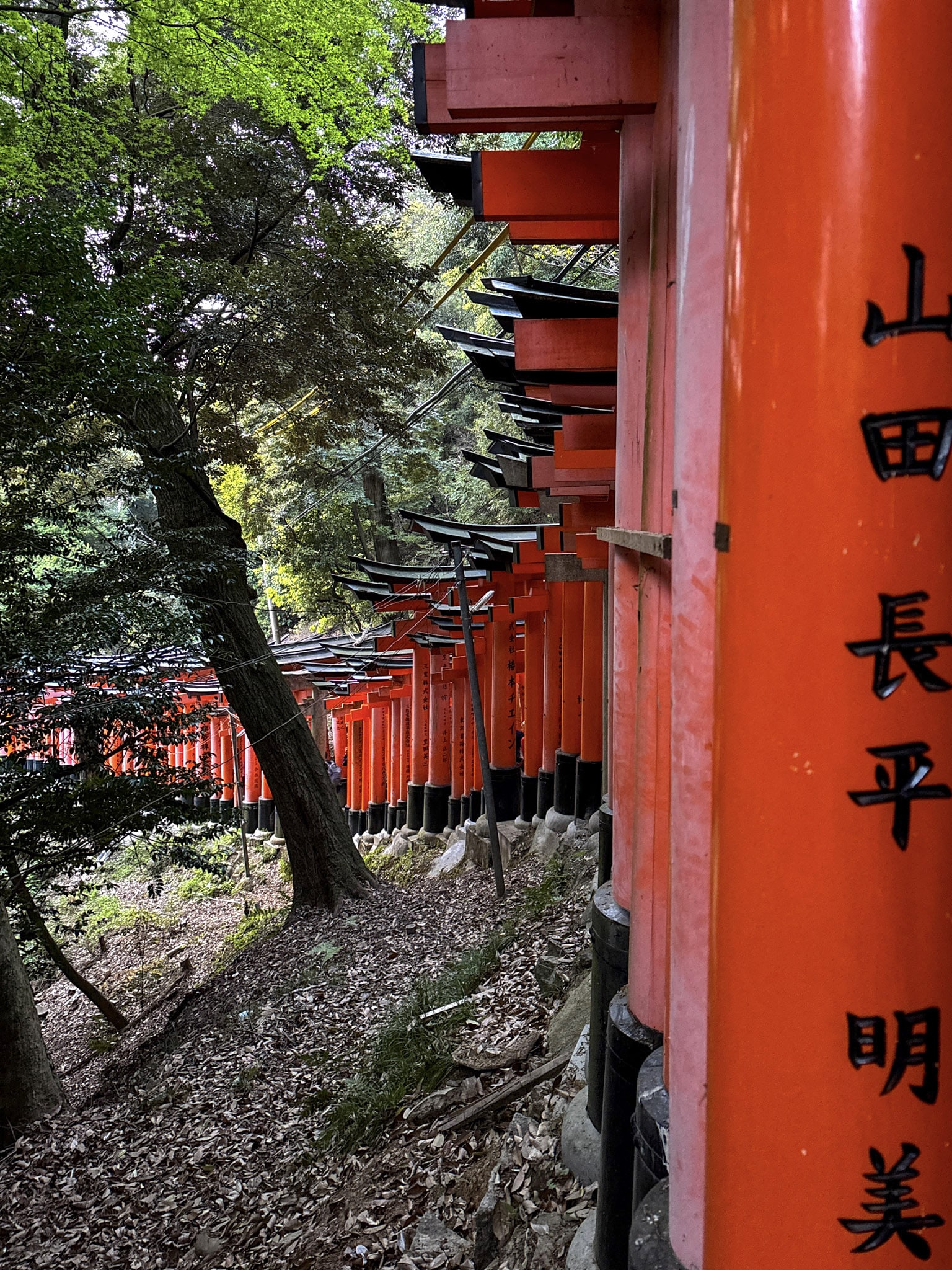
Route Options: Short Walk, Full Hike, and Hidden Trails
There are three main ways to experience the Fushimi Inari Hike, depending on how much time and patience you have:
The short walk is what most people do. It starts from the Romon Gate and climbs through the first long tunnel of red torii gates up to Yotsutsuji Intersection. You’ll pass dozens of small shrines, souvenir stands, and food stalls selling inari sushi and yakitori. It’s busy but easy, and you can be back at the station in under an hour. If you just want the classic photo, this is enough.
The full hike goes beyond Yotsutsuji, following stone steps that curve around the mountain and eventually reach the summit, marked by a modest cluster of shrines. The climb is steadier from here, with sections of forest so dense it feels like dusk even at noon. A complete circuit back to the base takes about two to three hours. There’s no sweeping view at the top — only moss, incense, and the quiet rhythm of footsteps.
The hidden trails branch off the main route between sub-shrines. Some lead to forgotten torii gates swallowed by bamboo, others to small neighborhoods where cats nap on stone walls. These paths aren’t exactly secret, but they’re where you’ll find the calm version of Fushimi Inari everyone wishes for. If you keep walking past where the crowds stop, the mountain slowly turns back into what it has always been: a sacred forest rather than a backdrop.
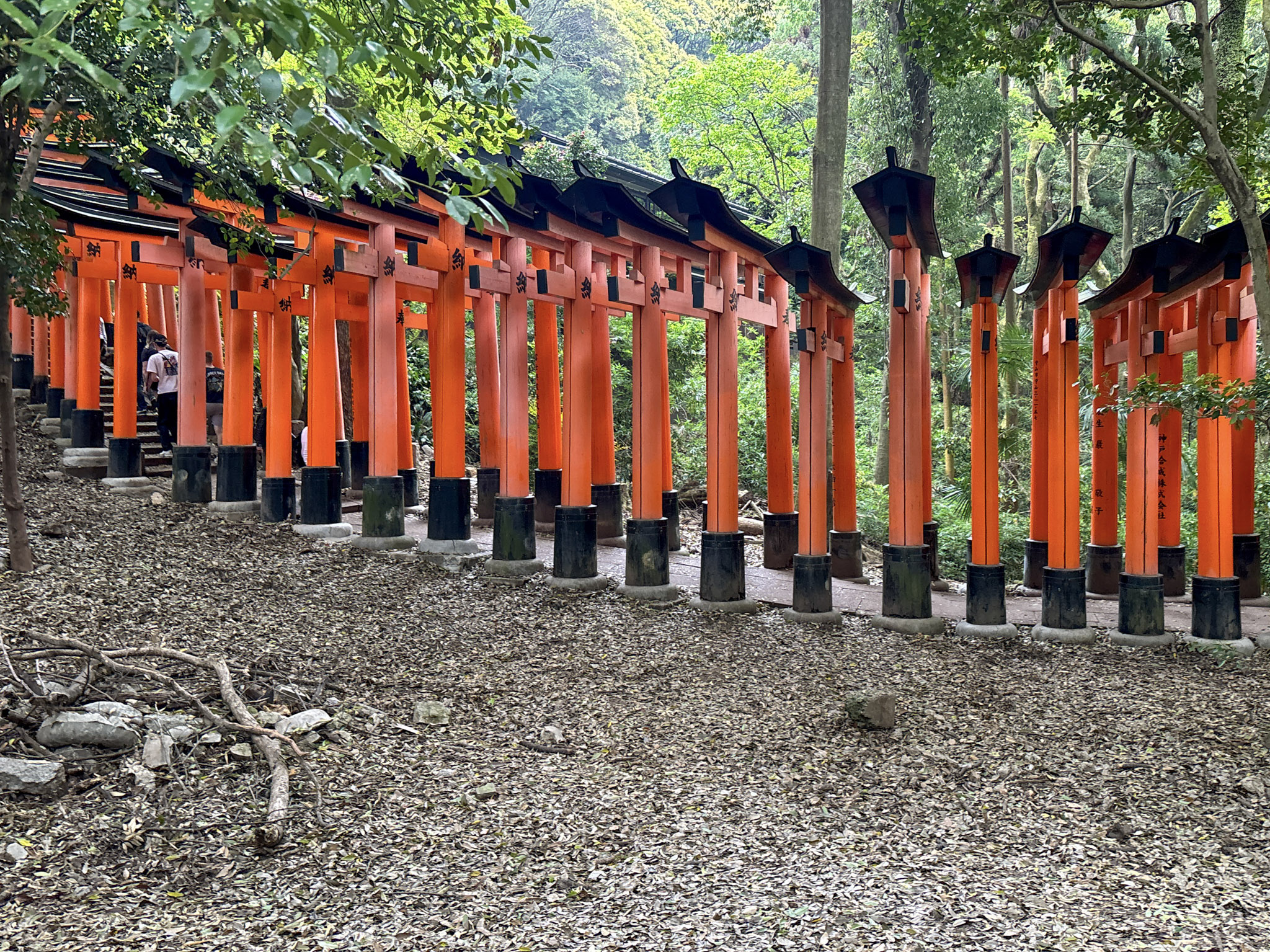
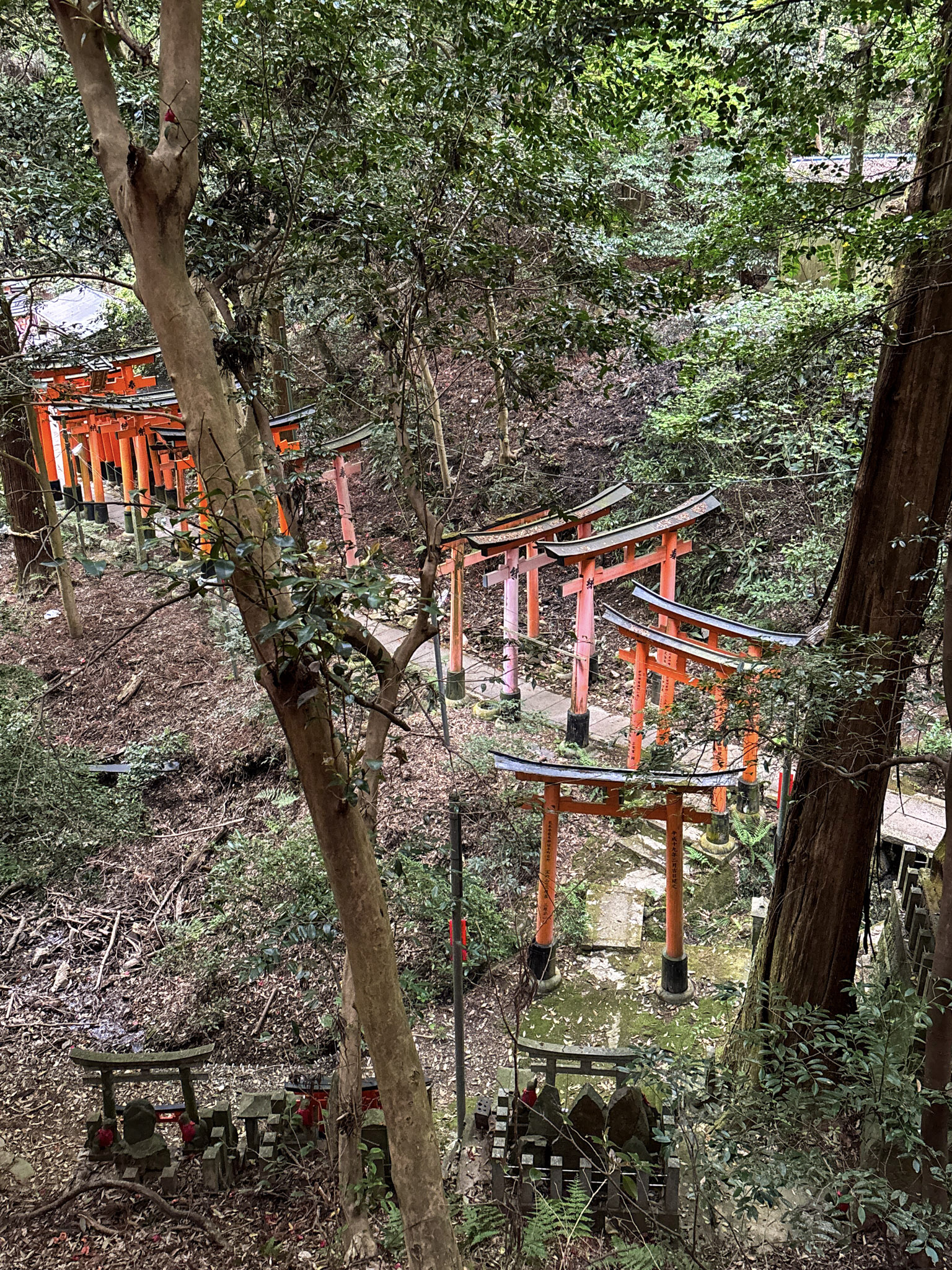

What to Expect Along the Trail
The first section feels almost like a crowded festival. Once you pass the lower torii and start climbing the narrower stone steps, the crowd begins to thin. The rhythm of the gates takes over — red, shadow, red again — and it becomes strangely hypnotic.
About twenty minutes in, you’ll reach the first rest area with vending machines and benches. From here, the air cools, and the forest thickens into tall cedar and bamboo. You’ll hear bells from nearby shrines and sometimes a rooster echoing from the homes below. The ground is damp year-round, and during summer the humidity clings to your clothes.
Every few hundred meters there’s a smaller shrine with offerings of sake bottles or ceramic foxes. Locals still come here to pray for business luck, so you might cross paths with someone quietly bowing at an altar while tourists file past. At night, lanterns flicker along the path and the gates seem endless.
The top section of the Fushimi Inari Shrine hike feels almost abandoned. The stone paths are uneven, the torii are darker with age, and the air smells faintly of incense and rain. By the time you descend, the noise of the city feels distant, and it’s hard to tell whether the mountain ever stopped.

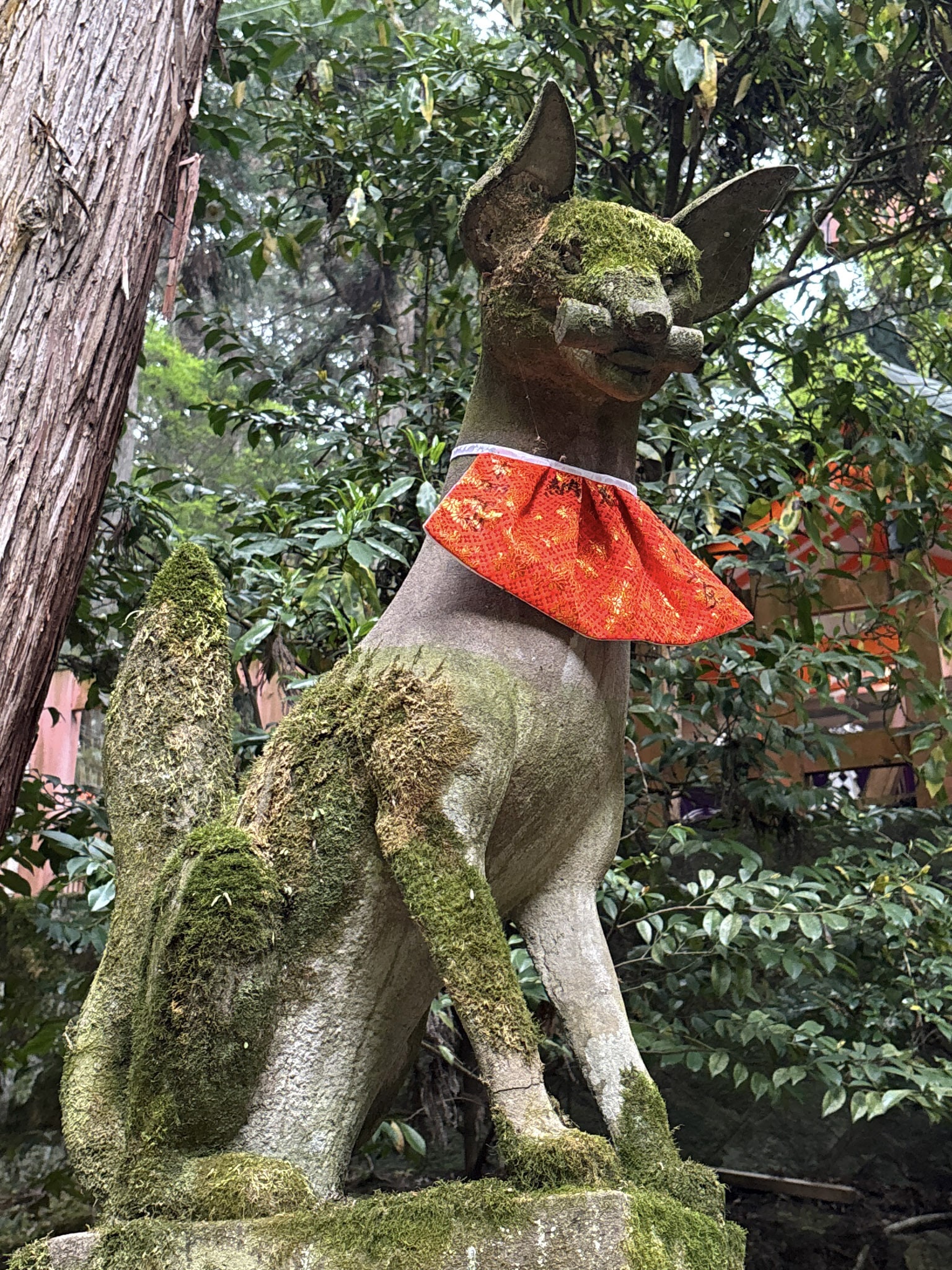
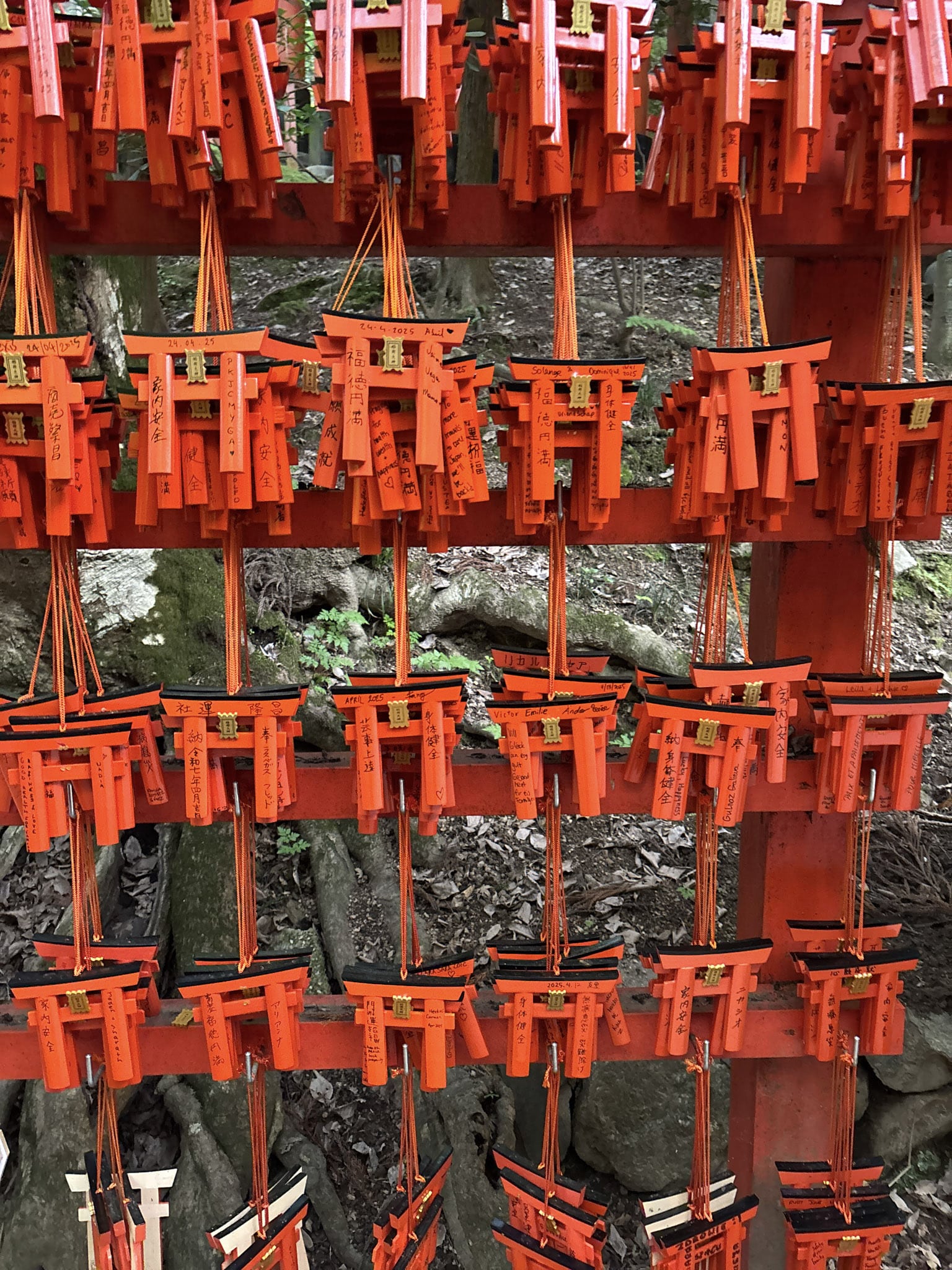
The Story Behind Fushimi Inari Shrine and Its Gates
The Fushimi Inari Shrine isn’t just the starting point of the hike, it’s one of Japan’s most important Shinto sites. Founded in 711 and dedicated to Inari Ōkami, the deity of rice and business prosperity, it’s still the head shrine for more than 30,000 Inari shrines across Japan. The fox statues everywhere are messengers of the god, usually carrying a key or a grain in their mouths.
Each of the thousands of torii gates you pass on the hike has a name written along the side. Those names belong to companies, families, or individuals who donated the gates as offerings, hoping for success or to give thanks for it. The practice started centuries ago and continues today: you can still pay to sponsor a new torii, though it’s not cheap. The smallest gates near the top cost around 400,000 yen, while the larger ones near the base run into the millions.
If you look closely, you’ll notice older gates turning dark red or black with age, while new ones shine bright orange. It’s a living record of devotion, constantly renewed.
Tips for a Better Fushimi Inari Shrine Hike
- Start early. The Fushimi Inari Hike is open 24 hours, and sunrise is when it feels closest to sacred. The light filters through the gates, the air is cool, and the steps are nearly empty. Arriving after nine means climbing in a slow line of people taking the same photo.
- Bring water and wear proper shoes. The path is paved but steep in places, and Kyoto’s humidity makes it slippery after rain. There are vending machines along the way, but the prices climb as fast as you do.
- Don’t expect a dramatic view at the summit. The reward of the Fushimi Inari Shrine hike is the walk itself, the repetition of the gates, the quiet shrines, the feeling that the city has disappeared below you. If you want scenery, the halfway viewpoint at Yotsutsuji is better.
- Avoid weekends and holidays, when local tour groups fill the lower path. Sunset is a good alternative if you can handle descending in dim light; the torii glow against the forest, and the atmosphere shifts from lively to dreamlike.
- Above all, remember this isn’t a theme park trail. It’s a working shrine on a sacred mountain. Walk quietly, move aside for worshippers, and it becomes a completely different place.
Is the Fushimi Inari Full Hike Worth It?
Photos of the lower gates at Fushimi Inari can be misleading. The crowds in those pictures make some travelers skip it altogether, assuming it’s just an overrun tourist spot. Others visit only for a few photos at the base and leave without realizing the hike continues far beyond. The truth sits somewhere in between.
The Fushimi Inari Hike is one of Kyoto’s most accessible and rewarding walks. It’s busy at the bottom, yes, but it’s also a living shrine that shifts quickly from city noise to deep forest if you give it a chance. The higher paths show you what locals love about the place: the quiet, the smell of cedar, the small shrines still in use.
You don’t need to reach the summit to understand it, but walking beyond the crowd changes the experience completely. It’s not a cliché if you actually keep going.
Keep reading:
10 Best Things To See in Tokyo for First-Timers
Planning your first Tokyo trip? Here are the 10 best things to see in Tokyo from sushi breakfast, through quiet shrines, and up to that crossing you’ve seen a thousand times online. [dssb_sharing_buttons icon_placement="icon" icon_width="fixed" alignment="left"...
Kamakura Day Trip From Tokyo: A Step-by-Step Walkthrough
Kamakura day trip from Tokyo, done right: bamboo forests, cliffside views, a coastal tram, and every stop tested on one relaxed, incredible loop.[dssb_sharing_buttons icon_placement="icon" icon_width="fixed" alignment="left" icon_color="#000000"...
Tokyo Subway: Your Essential Guide to Tokyo’s Public Transport
Tokyo’s train and subway map looks wild, but this guide breaks it down: tickets, IC cards, stations, exits, and how to tap your way through the city like a local.[dssb_sharing_buttons icon_placement="icon" icon_width="fixed" alignment="left" icon_color="#000000"...


